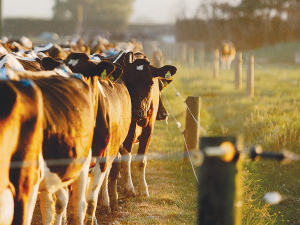Genetics, Efficiency and Performance: How the Burgesses are raising the bar at Te Poi
Bill and Michelle Burgess had an eye-opening realisation when they produced the same with fewer cows.
 The average six week in-calf rate is sitting at 69.3% for the 2023-24 season, up 2.7% from last season.
The average six week in-calf rate is sitting at 69.3% for the 2023-24 season, up 2.7% from last season.
New data released by LIC and DairyNZ shows New Zealand dairy farmers have achieved the highest six week in-calf rate and lowest notin- calf rate on record.
The average six week in-calf rate is sitting at 69.3% for the 2023-24 season, up 2.7% from last season (66.6%), while the not-in-calf rate is down to 15%.
The interim data, based on aged pregnancy test results from 4679 herds with a detailed DairyNZ fertility focus report in LIC’s MINDA software, represents 2.5 million cows from across New Zealand.
On a national scale, the DairyNZ InCalf calculator estimates these reproduction improvements could create $130.7 million in extra milk revenue.
DairyNZ senior scientist Chris Burke said improved reproduction performance could also help farmers to lower emissions.
“Herd reproductive performance is key in ensuring dairy farming success and in lowering methane emissions by reducing the number of non-productive cows. These results highlight the ongoing sector-wide opportunities to help farmers improve animal efficiency, to continue working towards emissions reduction goals.”
Jair Mandriaza, LIC senior reproduction solutions advisor, said this is great news for the dairy sector.
“From a national level, these results are very impressive and have been welcomed after a couple of tough seasons.”
Mandriaza noted the submission rate (the number of cows that were mated in the first three weeks) also increased compared to last season.
“It seems many farmers have implemented improved management practices to overcome those tough seasons and, coupled with favourable weather in many parts of the country, are now reaping the rewards of their hard work.”
Fonterra’s group director for Farm Source Anne Douglas says the latest results are particularly encouraging.
“Animal efficiency can improve farm profitability as well as positively impact a farm’s emissions intensity profile, which is important for our co-op,” says Douglas.
“We provide several tools and services supporting farmers, including our tailored Farm Insights Reports, and appreciate the work that LIC and DairyNZ are doing in this space.”
A Taranaki farmer and livestock agent who illegally swapped NAIT tags from cows infected with a bovine disease in an attempt to sell the cows has been fined $15,000.
Bill and Michelle Burgess had an eye-opening realisation when they produced the same with fewer cows.
It was love that first led Leah Prankerd to dairying. Decades later, it's her passion for the industry keeping her there, supporting, and inspiring farmers across the region.
Rangitikei Rivers Catchment Collective (RRCC) chairperson Roger Dalrymple says farmers in his region are taking a national lead in water quality awareness and monitoring.
One young couple is proving farm ownership is still within reach for young Kiwis.
Greenlea Premier Meats managing director Anthony (Tony) Egan says receiving the officer of the New Zealand Order of Merit (ONZM) honour has been humbling.
President Donald Trump’s decision to impose tariffs on imports into the US is doing good things for global trade, according…
Seen a giant cheese roll rolling along Southland’s roads?